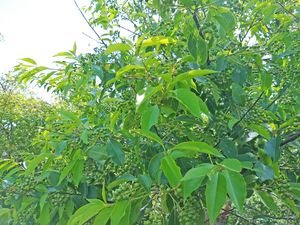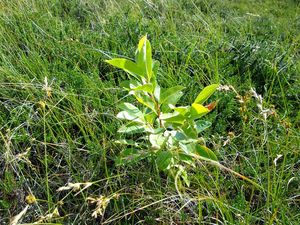Info page Prunus serotina (Black cherry)
What does the Prunus serotina look like?
 Fig. 1: Black cherry with unripe fruit
Fig. 1: Black cherry with unripe fruit
 Fig. 2: Black cherry (young plant)
Fig. 2: Black cherry (young plant)
The black cherry (Prunus serotina) is a tree shrub that grows up to 20 metres tall. The green leaves are elongated, ovate and slightly serrated at the edges. They are glossy on the upper side and light-coloured on the underside. They can grow up to 12 cm long. The bark is dark brown. The white and fragrant flowers appear towards the end of May and initially form purple-red fruits, which turn black when ripe.
Where does Prunus serotina originally come from? Where is it found?
Prunus serotina originally comes from America and can be found from Canada to Guatemala. Under optimal conditions, it can become the dominant tree species in the forests there and is utilised for forestry purposes.
In Germany, Prunus serotina was first mentioned in 1685 and is now very widespread. The sandy soils of the north German lowlands are particularly affected. It invades pine and larch forests and also grows in pine-oak forests. It is also frequently found in hedgerows around agricultural land.
How does Prunus serotina spread?
The ripe fruits are eaten by many bird species as well as fallow deer and other mammals and thus spread. The seeds have been observed to germinate better after intestinal passage in various bird species. The seeds can remain germinable in the soil for up to 5 years. In addition, Prunus serotina is capable of sprouting and can also form new plants from root fragments.
How does Prunus serotina affect its environment? What does this mean for nature conservation?
By spreading through birds or mammals, it invades open land biotopes, such as those found on the East Frisian Islands, where it can permanently change the landscape and species composition. Prunus serotina growth changes the availability of light and thus outcompetes other species.
Can Prunus serotina be confused with native plants?
It can be confused with the native Bird cherry (Prunus padus). The leaves of Prunus padus are dull and wrinkled in comparison and it flowers earlier than the late flowering weeping cherry.
Prunus serotina has a leafy inflorescence, a permanent calyx and toothed leaves and can therefore be easily distinguished from other species of the genus Prunus.
Countermeasures
Due to the plant's strong ability to regenerate, cutting back or cutting off is not promising. Young plants can be pulled out by hand. When sawing off and digging out older specimens, particular care must be taken to remove root fragments so as not to inadvertently encourage their spread. Possible countermeasures are very costly and time-consuming and require many years of reworking.
What can you do if you find the late weeping cherry in the wild?
The bark and seeds are poisonous and should not be eaten.
Own work
Neophyten auf der Insel Wangerooge - Bestandsaufnahme und Gefährdungspotenzial am Beispiel der Kartoffelrose, der Späten Traubenkirsche und des Schmalblättrigen Greiskrauts. Diplomarbeit von Sven Oltrop, Universität Oldenburg, November 2010.
Contact
If you have any questions, please contact:
Dr Markus Prinz: markus.prinz[at]uni-oldenburg.de
or PD Dr Holger Freund: holger.freund[at]uni-oldenburg.de

![[Translate to English:]](/f/5/_processed_/3/2/csm_ICBM-Logo-transparent-_91fe1c6774.png)